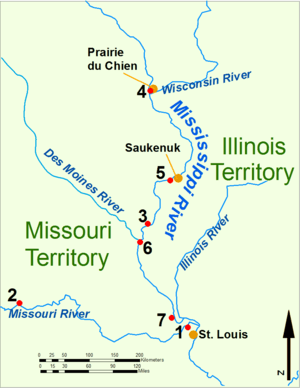Battle of the Sink Hole

The Battle of the Sink Hole was fought on May 24, 1815, after the official end of the War of 1812, between Missouri Rangers and Sauk Indians led by Black Hawk. The Sauk were unaware, or did not care, that their British patrons had signed the Treaty of Ghent with the U.S. The battle was fought in a low spot near the mouth of the Cuivre River in Missouri (present day City of Old Monroe), near Fort Howard and Fort Cap au Gris. An ambush by Sauk on a company of rangers led to a prolonged siege in which seven Rangers (including their commander, Cpt. Peter Craig) and one Sauk were killed. Conflicting accounts of the action were given by John Shaw[1] and by Black Hawk.[2]
After the battle, in 1816, Black Hawk reaffirmed the Treaty of St. Louis after re-negotiation with the United States government. [3]
References
- ↑ Stevens, Walter B. (1921). Centennial history of Missouri (the center state) one hundred years in the union. St. Louis: S. J. Clarke.
- ↑ Black Hawk (1916) [1834]. Milo M. Quaife, ed. Life of Black Hawk, Ma-ka-tai-me-she-kia-kiak. Chicago: Lakeside Press. pp. 66–68.
- ↑ "Black Hawk: Resisting American Expansion".
Coordinates: 38°56′00″N 90°41′13″W / 38.933384°N 90.687068°W